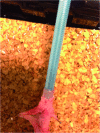Ureteral access sheaths: a comprehensive comparison of physical and mechanical properties
- PMID: 29493185
- PMCID: PMC5996793
- DOI: 10.1590/S1677-5538.IBJU.2017.0575
Ureteral access sheaths: a comprehensive comparison of physical and mechanical properties
Abstract
Introduction: Ureteral access sheaths (UAS) facilitate flexible ureteroscopy in the treatment of urolithiasis. The physical properties of UAS vary by manufacturer and model. We compared three new UAS: Glideway (GW, Terumo, 11/13Fr, 12/14Fr), Pathway (PW, Terumo 12/14F) and Navigator HD (NHD, Boston Scientific, 11/13Fr, 12/14Fr) in the domains of safety characteristics, positioning characteristics, lubricity and radioopacity.
Materials and methods: In vitro testing of the three UAS included safety testing-tip perforation force, sheath edge deformation and dilator extraction forces. Positioning characteristics tested included tip bending, stiffness (resistance to coaxial buckling forces), kinking (resistance to perpendicular forces), and insertion forces. Lubricity was assessed by measured frictional forces of the outer sheath. Finally, radio-opacity was tested utilizing fluoroscopic imaging of the three 12F sheaths and inner dilators.
Results: The PW (0.245 lb) and GW (0.286 lb) required less force for tip perforation compared to the NHD (0.628 lb). The NHD sheath edge deformation was mild compared to more severe deformation for the PW and GW. The PW (1.008 lb) required greater force than the GW (0.136 lb) and NHD (0.043 lb) for inner dilator removal. The GW (3.69 lbs) and NHD (4.17 lb) had similar inner dilator tip stiffness when bent, while the PW had the weakest inner dilator tip, 1.91 lbs. The PW (0.271 lb) was most susceptible to buckling and kinking (1.626 lb). The most lubricious UAS was the NHD (0.055 lbs for 12F). The NHD (0.277 lbs) required the least insertional force through a biological model and possessed the greatest radio-opacity.
Conclusions: Comparison of different commercially available UAS in various sizes reveals that there are mechanical differences in sheaths that may play a role clinically. The Terumo sheaths' (GW and PW) were outperformed by the Boston Scientific NHD in simulating safety, ease of use and radio-opacity.
Keywords: Ureter; Ureteroscopy; instrumentation [Subheading].
Copyright® by the International Brazilian Journal of Urology.
Conflict of interest statement
Conflict of interest: None declared.
Figures







References
-
- Kourambas J, Byrne RR, Preminger GM. Does a ureteral access sheath facilitate ureteroscopy? J Urol. 2001;165:789–793. - PubMed
-
- Vanlangendonck R, Landman J. Ureteral access strategies: pro-access sheath. Urol Clin North Am. 2004;31:71–81. - PubMed
-
- Pietrow PK, Auge BK, Delvecchio FC, Silverstein AD, Weizer AZ, Albala DM, et al. Techniques to maximize flexible ureteroscope longevity. Urology. 2002;60:784–788. - PubMed
-
- Delvecchio FC, Auge BK, Brizuela RM, Weizer AZ, Silverstein AD, Lallas CD, et al. Assessment of stricture formation with the ureteral access sheath. Urology. 2003;61:518–522. - PubMed
-
- Auge BK, Pietrow PK, Lallas CD, Raj GV, Santa-Cruz RW, Preminger GM. Ureteral access sheath provides protection against elevated renal pressures during routine flexible ureteroscopic stone manipulation. J Endourol. 2004;18:33–36. - PubMed
Publication types
MeSH terms
LinkOut - more resources
Full Text Sources
Other Literature Sources
